THE CHARITY OF THE EMPRESSES FROM THE FIFTH CENTURY ACCORDING TO DATA FROM BULGARIA
THE CHARITY OF THE EMPRESSES FROM THE FIFTH CENTURY ACCORDING TO DATA FROM BULGARIA
Author(s): Dochka Vladimirova-AladzhovaSubject(s): Cultural history, Museology & Heritage Studies, Economic history, Ancient World
Published by: ДВНЗ Переяслав-Хмельницький державний педагогічний університет імені Григорія Сковороди
Keywords: coin find; treasure; Late Antiquity; empresses from 5th century; Christian symbols;
Summary/Abstract: The sources speak eloquently about the extreme charity of the empresses from 5th century. They built temples, orphanages and supported their work. Their mission was spread all over the empire, which is proved by the discovered coins of theirs. The golden coins which they donated not only supported the church financially, but also helped their activity in disseminating and establishing the Christian religion. The signs of Christ complement and in separate cases prevail over their pragmatic properties. The difference about the view about the role of the monetary units of the empresses is that their “spiritual value” in 5th century was also an important means for the state politics not only a medium of exchange. The support of the religion life at places had not only financial dimensions, which for that age was of extreme importance. That process underwent in an atmosphere of impoverishing of the town population, as the church advanced economically with the help of the state. That explains the fact why in the church buildings and around them such a great amount of coins from 6th century has been found, but near the public ones they decreased at the end of 4th century. The discovery location of the coins of the empresses clearly shows the area and the sites, connected with charity and religious activities of the Augusts. At the dissemination and establishing the Christianity the state used all possible means. It was imperative because of the heterogeneous ethnic structure of the population of Trace and Dacia during 4th-6th centuries, which created conditions for arising of various diversions from the Christian religion – the heresies. The inspection of the location of findings golden coins of empresses shows that they were discovered in/or at a short distance from the region of the Late Antiquity settlements and fortresses: Abrittus (now Razgrad), Beroe – Augusta Traiana (now Stara Zagora) Nicopolis ad Istrum – the old settlement near the village of Dichin, Kyustendil, Nicopolis ad Nestum (now Gotse Delchev), Strogovia (Kailuka – Pleven), Ryahovets, Sadovets, Tuida (now Sliven), Philipopolis (now Plovdiv), the fortress of Shumen. The listed places coincide with the territories with bishop centers, significant population and outstanding Christian temples from 4th and 5th centuries. It gives a good reason to search the connection between the gold in question, the cult artifacts and their religious meaning. During the Late Antiquity the role of the bishop institution increased rapidly, not only in the church life, but also in the civil ruling system. The area bishops began to take active part in the control of the towns, occupying a great deal of the town curia functions. That happened with the blessing of the emperor’s power, which gave such authority to the bishops, so that they were able to control and inspect various decisions of the non-clerical authorities. The topography of the monetary unit subject of the article is a good token in their interpretation as a means of propaganda of the still new Christian religion where the preliminary and dictatorial reasons of the emperor institution could be seen. The coins are subject of this study; they concentrate the ideological power in the image of еmpresses. Coupled with the Christian symbols they outline a spiritual vector in their dissemination. Thus the commercial role of money was combined with their spiritual mission to help the church establish the faith in Christ.
Journal: Український Нумізматичний Щорічник
- Issue Year: 2022
- Issue No: 6
- Page Range: 169-180
- Page Count: 12
- Language: English

